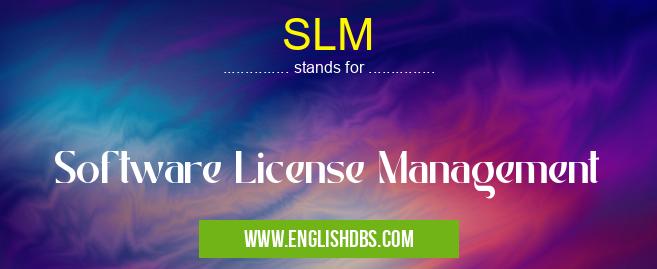What does SLM mean in MANAGEMENT
SLM (Software License Management) is a critical practice for businesses to ensure the proper use and compliance with software licenses. It involves the tracking, monitoring, and managing of software licenses throughout their lifecycle, from procurement to retirement. Effective SLM enables organizations to optimize their software assets, reduce costs, and avoid legal or financial penalties.

SLM meaning in Management in Business
SLM mostly used in an acronym Management in Category Business that means Software License Management
Shorthand: SLM,
Full Form: Software License Management
For more information of "Software License Management", see the section below.
» Business » Management
What does SLM stand for?
SLM stands for Software License Management.
How does SLM work?
SLM typically involves the following processes:
- Inventory and Discovery: Identifying and tracking the software installed on all devices within an organization.
- License Reconciliation: Matching software usage with the corresponding licenses to ensure compliance.
- Procurement Management: Optimizing software purchases and ensuring cost-effective renewals.
- Usage Monitoring: Tracking the utilization of software to identify areas for optimization or cost savings.
- Compliance Management: Adhering to software license agreements and industry regulations to avoid penalties.
Benefits of SLM
- Cost Optimization: Reduced software expenses through license consolidation and negotiation.
- Compliance Assurance: Avoidance of legal and financial risks associated with unlicensed software use.
- Improved Security: Enhanced security by ensuring software is up-to-date and properly licensed.
- Increased Productivity: Optimized software utilization leading to improved efficiency and productivity.
- Better Asset Management: Centralized visibility and control of software assets, facilitating decision-making.
Essential Questions and Answers on Software License Management in "BUSINESS»MANAGEMENT"
What is Software License Management (SLM)?
SLM is the process of managing and tracking software licenses throughout their lifecycle to ensure compliance, optimize usage, and reduce costs. SLM involves activities such as license acquisition, inventory tracking, usage monitoring, compliance reporting, and end-of-life management.
Why is SLM important?
SLM is important because it helps organizations:
- Maintain compliance with software license agreements, avoiding legal penalties and reputational damage.
- Optimize software usage, ensuring licenses are used effectively and not wasted.
- Reduce costs by identifying underutilized licenses and negotiating better licensing deals.
- Improve IT security by providing a comprehensive view of all software installed on the network.
What are the key components of an SLM program?
The key components of an SLM program typically include:
- License inventory: A comprehensive database of all software licenses, including details such as the vendor, product, version, and license count.
- Usage monitoring: Tools to track how software is being used, including metrics such as user count, frequency of use, and peak usage times.
- Compliance auditing: Regular reviews to ensure that software usage is compliant with license agreements and industry best practices.
- Reporting and analytics: Reports and dashboards that provide insights into license usage, compliance status, and cost optimization opportunities.
What are the benefits of implementing SLM?
Implementing SLM can provide organizations with numerous benefits, including:
- Reduced software costs through license optimization and negotiation.
- Improved compliance and reduced legal risks.
- Enhanced IT security by identifying vulnerabilities and unlicensed software.
- Increased efficiency in software procurement and management.
- Improved decision-making through data-driven insights into software usage.
Final Words: SLM is an essential practice for businesses to manage their software licenses effectively. It helps organizations optimize costs, ensure compliance, improve security, and enhance productivity. By implementing a comprehensive SLM strategy, businesses can gain control over their software assets and maximize their value.
